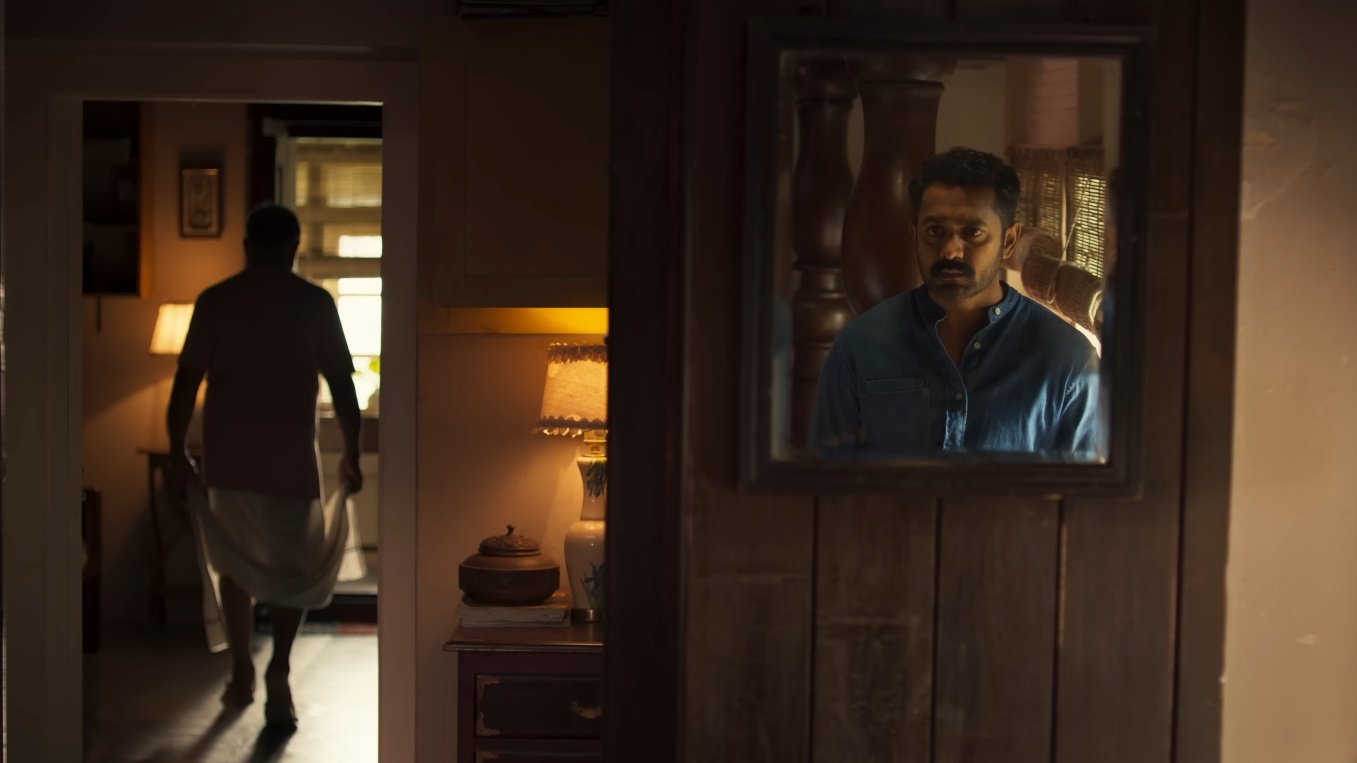
The setting is a dense green village adjacent to a fictitious reserve forest in Kerala. The geography of the locale and the conversations suggest that it is somewhere around Nilambur in Malappuram district. As the title indicates, Dinjith Ayyathan’s Kishkindha Kaandam is based on the mysterious events in an ancestral house surrounded by troops of monkeys.
The family patriarch Appu Pilla (Vijayaraghavan) is a bitter man whose habits are peculiar to his new daughter-in-law Aparna (Aparna Balamurali). Her husband and Pilla’s son Ajaya Chandran (Asif Ali) is an officer at the Forest Department. The father-son duo shares an unfriendly status quo, and we sense something is amiss right from the beginning. At one point, we believe it is due to Ajayan’s son Chachu’s (Master Aarav) disappearance. Then we doubt if there’s a family secret we aren’t told about. We tend to ponder if the father’s suspicious behavior – such as his recurring habit of burning paper in the yard – has something to do with a series of events unfolding in the region. The narrative also involves a missing pistol that belongs to Pilla – a former military officer.
In an amusing and somewhat unexpected exploration of masculinity, Kishkindha Kaandam brings three generations – Pilla, Ajayan, and Chachu. Pilla’s anger and tenacity are imbibed by Chachu in the absence of his soft-natured dad. While the household seems as regular as any family unit in Kerala, a series of video clips from an old camera brings in a sense of disbelief and gives its curious leading lady some footage for research.
We rarely see Ajayan speak firmly to his dad. In a family of two alpha males, he is an omega. He never clashes with the other two – despite his age and authority. We see the alphas clash at one point – an event that makes way for the mysteries in Kishkindha Kaandam. There’s a France-bound elder son in the arc (Ashwin Matthew) who is no longer a part of the chaos.

Ayyathan’s film runs at a leisurely pace which renders its 2-hour-long runtime positively agitating. Kishkindha Kaandam also has a parallel track around Pilla’s missing gun and the probability of it being with the local monkeys. What are the odds of monkeys loading and operating a heavy pistol? It is low, but can the system that oversees an area with Naxalite presence rule it out entirely? No. Throwing in dollops of dark humor to this angle, Ayyathan shocks us with a terrifying interval block. It almost teases us to solve the puzzle but the film ups the ante in the latter half with cleverer twists.
Primates are a curious bunch and we humans, being their smartest reps, enjoy solving things – whether it’s a Rubik’s cube or a mystery thriller film. The genre works best if it can hold your attention until the big reveal and if the build-up forms a jigsaw-like structure. Kishkindha Kaandam scores on both counts. Except for Aparna, most of its principal characters wear a shade of secrecy. If Ajayan’s state of denial is an instant cause of suspicion, Jagadish’s Sumadathan is that man in the plot who knows something. Nizhalgal Ravi appears as a former military colleague of Pilla. An eerie sequence featuring the two would send a shiver down your spine.
The tense narrative is further fueled by Vijayaraghavan and Asif Ali’s subdued yet towering central acts. If the former applies his veteran status to deliver an internalized take on a defeated yet honorable family head, the latter is a scene-stealer in a quiet and heartbreaking part. The father-son duo bears obvious character flaws, yet Kishkindha Kaandam makes us look at them with kindness. Aparna Balamurali puts on a fantastic show as the prime catalyst who actively drives the viewers’ interest. Nishan makes a welcome return to Malayalam cinema in an important cameo. It is pleasant to watch Jagadish and Ashokan ace dramatic parts diverting from their iconic ‘Thomasukutty vittoda’ days.
ALSO READ: ‘Aarkkariyam’ review – a mercurial Malayalam drama around a dirty family secret
With abundant aerial shots of the jungles, Kishkindha Kaandam is filled with lush green frames. The fact that the writer also happens to wield the camera, gives the film a unique edge. With a studied focus on foliage, plants, monkeys, and the house’s exteriors, Bahul Ramesh lets his props evolve along with his characters’ psyches. He is ably aided by the editor’s (Sooraj E S) razor-sharp cuts that work wonders with the art of repetition. To call for a more familiar parallel, it is a Drishyam-like narrative but is way more creative in design. Mujeeb Majeed’s original score is moody and effective in a songless film with stellar sound design (Renju Raj Mathew).
As it ends, Kishkindha Kaandam paints an emotionally potent picture highlighting Ajayan’s wounds, Aparna’s curiosity, and Pilla’s integrity. It is not a film that is high on scale (like, say, Bramayugam). The lack of theatrics in this genre comes with the danger of its mystery not registering. With a compassionate and imaginative screenplay, it depicts how the simplest of lives are often underscored with blood, tears, and layers of complexities.
Rating: ★★★★ 1/2

